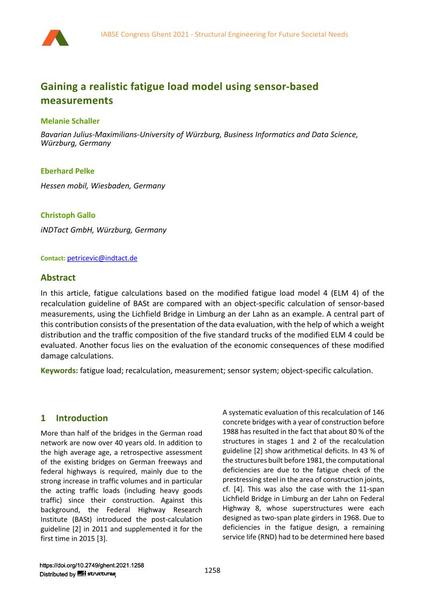Gaining a realistic fatigue load model using sensor-based measurements

|
|
|||||||||||
Détails bibliographiques
| Auteur(s): |
Melanie Schaller
(Bavarian Julius-Maximilians-University of Würzburg, Business Informatics and Data Science, Würzburg, Germany)
Eberhard Pelke (Hessen mobil, Wiesbaden, Germany) Christoph Gallo (iNDTact GmbH, Würzburg, Germany) |
||||
|---|---|---|---|---|---|
| Médium: | papier de conférence | ||||
| Langue(s): | anglais | ||||
| Conférence: | IABSE Congress: Structural Engineering for Future Societal Needs, Ghent, Belgium, 22-24 September 2021 | ||||
| Publié dans: | IABSE Congress Ghent 2021 | ||||
|
|||||
| Page(s): | 1258-1263 | ||||
| Nombre total de pages (du PDF): | 6 | ||||
| DOI: | 10.2749/ghent.2021.1258 | ||||
| Abstrait: |
In this article, fatigue calculations based on the modified fatigue load model 4 (ELM 4) of the recalculation guideline of BASt are compared with an object-specific calculation of sensor-based measurements, using the Lichfield Bridge in Limburg an der Lahn as an example. A central part of this contribution consists of the presentation of the data evaluation, with the help of which a weight distribution and the traffic composition of the five standard trucks of the modified ELM 4 could be evaluated. Another focus lies on the evaluation of the economic consequences of these modified damage calculations. |
||||
| Copyright: | © 2021 International Association for Bridge and Structural Engineering (IABSE) | ||||
| License: | Cette oeuvre ne peut être utilisée sans la permission de l'auteur ou détenteur des droits. |
||||
